
Outsourced Content Writing vs. In-House Content Writing – A True Cost Comparison

It’s no secret that quality content improves brand awareness, increases customer loyalty and drives leads, but most marketing managers say that good writers are difficult to find. Companies need writers who can create value through informative and engaging information. So, do you outsource your content to freelance writers or build an in-house team?
In this report, we discuss the pros and cons of each strategy and follow with a detailed breakdown of the costs of in-house vs outsourcing writing teams into four separate scenarios. Data is drawn from government reports, employment websites and industry surveys, and we’ve included a side-by-side comparison to help you determine how much you can expect to spend on in-house writers versus outsourcing your content creation.
How Much Content Do You Need?
How much content do you really need to execute a successful content marketing campaign? While this number will differ for each individual company, a great place to start is to look at the amount of resources other companies are putting towards content creation:
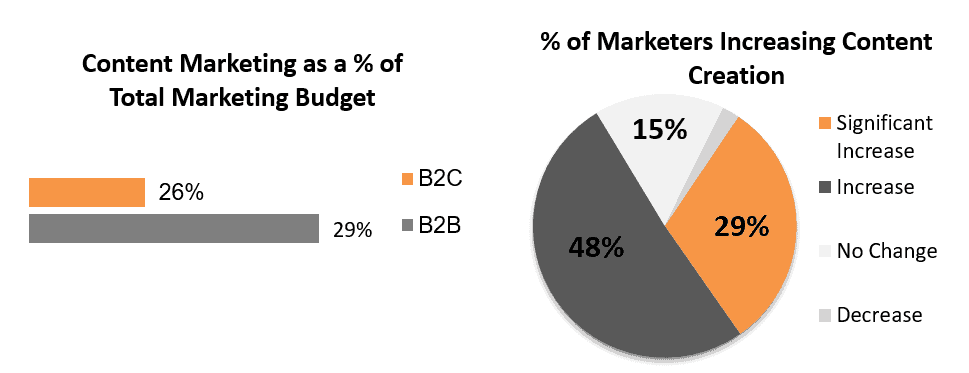
These numbers are from The Content Marketing Institute’s survey of over 400 marketers across North America. As you can see, most of the companies that were surveyed are currently setting aside nearly 30 percent of their total marketing budget to content marketing.
In addition to that, 77 percent of companies plan to increase their overall content production going forward.
Increasing Content Creation Can Lead to Better ROI
How does increased content production affect your bottom line? Generally, businesses that publish more earn more. Here’s what Hubspot discovered about blogging frequency and inbound traffic:
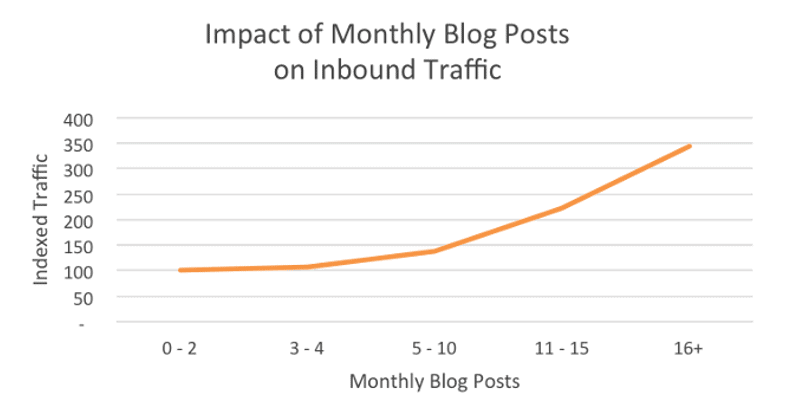
Notice that those companies that put out 16 or more blog posts per month saw three times the amount of traffic compared to those that published only one or two. Ultimately, the amount of content you distribute depends on your profile and strategy, but it’s clear that successful companies are finding ways to create and distribute more content and bring in more traffic/leads.
In-House Content: Pros and Cons
To get the most out of your strategy, you need to weigh both qualitative and quantitative factors.
Advantages
Let’s first look at the advantages of hiring and managing your own team of in-house writers.
Industry Experience
Increased Control
Disadvantages
Of course, in-house content creation also comes with several disadvantages:
Bias
Forbes Insights & PwC surveyed over 350 executives. Ninety-four percent agreed that personalization is key to delivering valuable content. However, value drops when writing gets too promotional, which is often the result of internal bias. An outsourced content creation company may be more objective and better able to identify hidden deficiencies and opportunities.
Skills Gap
Fixed Capacity
Whether you bring on one writer or 10, your volume will be capped. This poses major problems for seasonal or large, intermittent orders. Refer to the CMI survey figures. Like most marketers, you probably want to increase content production next year. If so, be prepared to substantially boost your salary budget by hiring more writers. Otherwise, your quality will decline.
Time/Resources
Outsourced Content: Pros and Cons
Now, for outsourcing content creation through a content writing company.
Advantages
Here are the main advantages of buying content from a content writing agency:
Convenience
Depending on the content writing companies you use, you’ll likely have the option of utilizing account management. This means you’ll have someone else training, managing and giving feedback to writers for you. Your only responsibility is to give direction on the types of content you need and any keywords/topics to focus on. Many content writing agencies offer additional quality assurance services (editing) to help ensure your content is publish-ready when you receive it. This can take a load off your to-do list and let you focus on other aspects of your business.
Process Expertise
Quality is by far the top success factor among content marketers. Because content creation companies specialize in writing, you can spare a lot of resources by outsourcing this segment of your strategy.
Ability to Scale
Creating purposeful content takes training and practice, particularly when it comes to keyword-based writing and SEO. With a content writing company comes experience and with experience comes speed. Additionally, online content writing companies usually have much larger writing teams to handle projects at scale. Consider online product catalogues; outsourcing is particularly beneficial for large-scale, short-term projects.
Resources
A content writing company can give you access to an expansive network of specialty writers. Other resources may include content curation, standalone editing and proofreading, product descriptions, category descriptions, stock images, social media planning, white papers, e-books, digital content strategy and more. Better still, you can easily increase/decrease your order volume without sacrificing time, quality or your salary budget.
Outside Perspective
Disadvantages
Likewise, here’s the downside of outsourcing your content to a content writing service:
Lack of Inside Knowledge
No third party knows your brand better than you do. While content writing services typically have a plethora of experience in general industry niches, specialty niches can push the limits of what a content writing company can produce. Depending on your niche, it may take time for a content creation company to learn your products and how to speak to your customers.
Limited Control
Any type of outsourcing limits your control to some degree, but much of the conflict is the result of middlemen. Many professional content writing services suffer from overextension, which can delay campaigns and blur communication lines. The key is to partner with a content writing company that focuses on one specific element of your strategy, such as writing or editing.
The Cost of Hiring In-House Writers
Before we analyze specific budgets and goals, let’s break down the five major costs associated with staffing one writer. Note that hiring and overhead are typically one-time expenses, while all other items are balance sheet accounts, or ongoing costs.
Hiring
Unless you work with freelance writers, hiring an in-house writer is like hiring any other employee. According to the Society for Human Resource Management (SHRM), the average cost-per-hire (CPH) is $4,129. This American National Standard metric factors in both internal and external costs, including those spent on job posting, screening, interviewing, onboarding and training. SHRM’s analysis includes nearly 4,000 data observations from four categories:
- Executive
- Middle Manager
- Non-Manager Individual Contributor
- Non-Exempt Non-Manager
Content writers typically fall under category three, which accounts for roughly 25 percent of the sample. Therefore, our breakdown is based on a conservative average hiring expense of $4,000.
Content Writer Salaries
The following annual salary figures for content writers are drawn from seven different employment websites across multiple writing job positions:
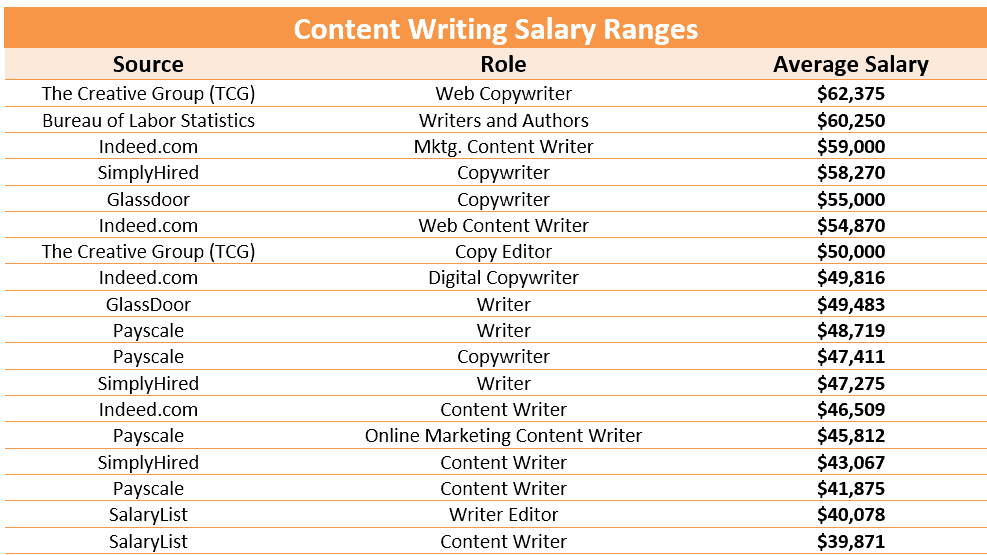
We took an average of these 18 copywriter salaries to come up with a base salary figure of $49,982.
While this average leans conservative, keep in mind that content writer salaries vary widely by city and region. For an even more accurate estimate, choose a city from the chart below. Simply divide the variance number by 100 and multiply the result by the writer salary ranges above.
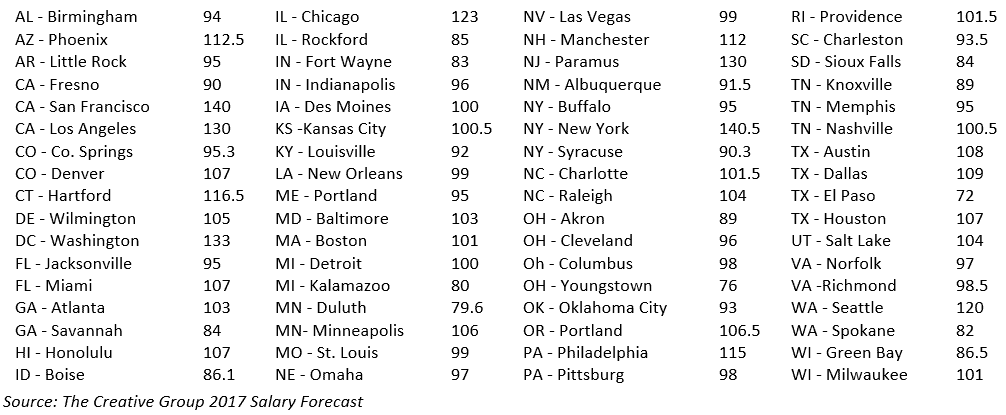
Benefits
According to the Bureau of Labor Statistics (BLS), benefits account for 30.2 percent of employee compensation costs within the private sector. The breakdown includes paid leave, supplemental pay, health insurance, retirement and legally-required benefits. Using this percentage, here are the annual benefits costs of hiring a content writer:

Payroll Taxes
All employers are also required to pay a portion of the Social Security and Medicare taxes. In addition is a 6 percent federal unemployment tax (FUTA) on the first $7,000 in wages.
However, you can reduce this rate by paying your state unemployment tax (SUTA). State governments use their own ranges based on employer profiles, and companies with low turnover generally receive lower rates. Here are examples of a typical payroll tax cost breakdown in three different cities at three different writer salary rates:
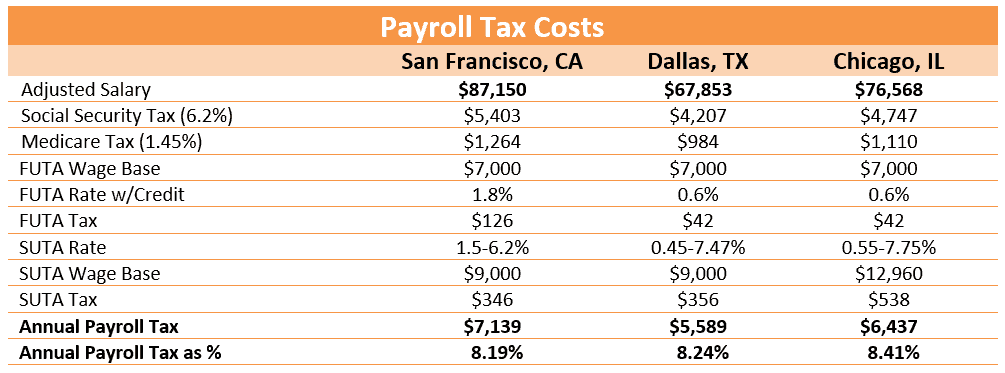
The totals were computed using range averages for SUTA. You can also access 2017 Payroll Tax Rates by State. We used 8.24 percent as the rate and came up with a cost of $4,119 for Payroll Taxes.

Equipment/Overhead
Like other roles in marketing, in-house writing is typically an office-based job. Equipment/overhead refers to supplies, rent, utilities, data subscriptions, etc. Moreover, many of these are typically one-time costs.
We identified five office furniture retailers that specialize in cubicle space. Using the median price in each product line as a variable, here are the averages of one-time overhead:
- Furniture Cost – $1,500
- Computer Setup – $1,000
- Database Programs, Plagiarism Services, Industry Journal Subscriptions – $300
Assuming that your content writers work on site, that you have existing free space and that any resulting changes to your supplies and utilities accounts are immaterial, you can expect approximately $2,800 in one-time overhead.
Now that we’ve looked at all of the major cost factors of hiring a writer in-house, let’s see what our total cost per employee for the first year adds up to be:

The Cost of Outsourcing Content Creation
When outsourcing the creation of your content, you’ll find that most content writing companies offer their services in one of two ways (or both):
- Self-Service
- Managed Service
Self-Service
Self-service refers to a hands-off approach by the content writing service where businesses use an online platform, create and place individual orders, select a price level, and manage and quality check the resulting content with each individual writer once it has been completed.
This option is typically the cheapest of the two (and the most time consuming) and most resembles the process in which you’d interact with an in-house writer, but with the caveat of having to manage your content through that content provider’s specific platform.
Managed Service
Managed writing service offers companies additional value in the customer service and convenience department. With this option, you’ll usually have access to a dedicated account manager who will consult with you on projects, create a dedicated team of writers around your campaigns and manage your team of writers. You’re left only with the task of placing an order. Keep in mind that not all content writing services offer account management, and not all managed writing services have the same perks.
Some features included in account management can be additional to the cost of the content. These might include content strategy, proofreading, editing, keyword research, meta info, images and blog posting, among others.
Many online writing companies require a $2,500 – $10,000 retainer from clients in order to take advantage of managed services. Others have a monthly membership fee. For our comparison, we’ll use the managed service model here at BKA Content, which doesn’t require a retainer or membership fee and comes at no extra cost.
Pricing Structures
Pricing for outsourced content companies typically falls under one (or more) of the options below:
- Pay per hour
- Pay per article
- Pay per word (based on writer quality level)
While there are some content writing companies that exclusively use the “pay per hour” pricing method, they are rare. An outsourcing system run entirely on a “pay per hour” model may encounter many of the same scaling/pricing issues as using an “in-house” writer, thus eliminating many of the benefits of outsourcing.
For the “pay per word” options, you select a quality level of writer based on that content provider’s grading rubric (i.e. a star rating from one to five) and adjust the price from there. Most providers have copywriting cost per word between 1-10 cents per word, excluding special custom projects.
Here at BKA Content, we are a combination of both “pay per article” and “pay per word.” Clients first select the product type they’d like to order (which has a certain quality level of writers attached who’ve been trained on the product type), and then they select the desired word count.
Total Cost
For our cost comparisons, we’ll be using a cost per article model rather than a cost per word copywriting model. We’ll use two common article products – blog posts and product descriptions – to use as the standard.
The prices for outsourcing content creation used in this comparison will reflect the current pricing we have for these products here at BKA Content. Keep in mind that our pricing also takes into consideration the perks of having managed writing services at no additional cost.
Prices for Blog Posts and Product Descriptions (not including volume discounts)
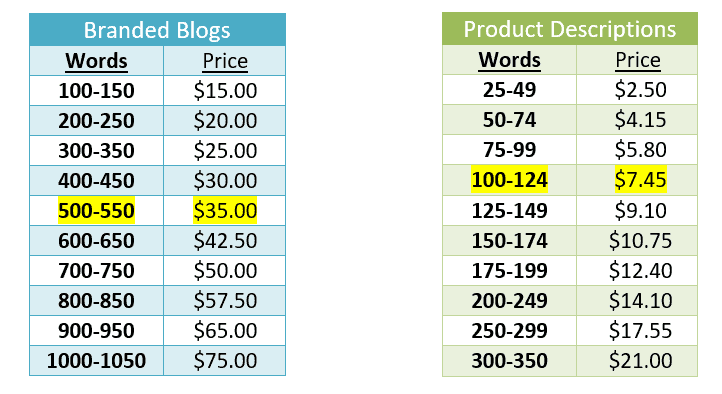
To compare with other content creation companies that price per word based on writer quality level, the writers who create our blog post products equate to a four or five-star level of writing.
Now that we have an idea for the total cost of an in-house writer as well as the total cost for outsourcing to online writing companies, it’s time to decide how many freelance writers you actually need. Let’s talk productivity.
How Much Can One Writer Produce?
In the content world, we often think in terms of word count. But how do words equate to time? In 2016, Hubspot asked over 4,000 marketing professionals exactly how long it took them to write a 500-word blog post.

Around 56 percent of those surveyed said it takes them between one and three hours to write a 500-word blog post. For simplicity’s sake, we’ll say it took them an average of two hours to write a single article. Here’s how this would convert to a monthly number of articles that one writer could produce (based on an eight-hour work day, five-day work week and a 52-week year):

To delve a little deeper, here at BKA Content we surveyed our own team of 250+ freelance writers to determine writing speeds. We adjusted for six distinct product categories and set the average article size at 500 words. Here are the results we found:

It’s important to remember that the 163-a-month number is specifically derived from freelance writers who have extra incentive to work both efficiently AND quickly. While a freelance writer probably hits this speed on occasion, they also aren’t typically writing eight hours a day, five days a week.
To make this a straight comparison going forward, we’ll use an average of the two writing speeds above. Keep in mind that this is an average spread across different content product types at that same word count. If you intend to only create one specific type of content, this number could be higher or lower depending on the guidelines/research involved.
At 500 words, one full-time content writer can produce, on average:
Articles/Month
Side-by-Side Cost Comparison Scenarios: In-House Writing vs. Outsourced Content Writing
Below, we’ve created four scenarios that each represent a unique company profile with specific content writing needs. The average article length is set at 500 words (except for scenario 4, which includes 100-word product descriptions). We’ve split up these scenarios to show the direct comparison between in-house writing costs and outsourced writing costs over a set amount of time.
In Regard to Content Volumes:
We’ve picked volumes of content for each of the scenarios with two things in mind. First is a realistic number based on our experience working with these types of businesses. Second, using the 125 articles a month per writer maximum as a base, we’ve selected volumes that would use the in-house writers near capacity to show their greatest value (scenarios 2, 3 and 4).
Keep in mind that monthly volumes that fall above or below multiples of 125 would increase the cost of in-house writing because you’d be paying more people to do less than their capacity to fulfill the volume. Even if you hired multiple part-timers, you would still incur the initial hiring costs to bring them on board as well as substantial equipment/overhead costs.
Outsourced writing costs, however, would always be equal to the volume of work needing to be done.
In Regard to In-House Writing Costs:
For monthly and annual writing costs, we factor in salary, benefits as a percentage of salary (excluding scenario 4) and payroll taxes. One-time writing costs include hiring expenses and overhead for every one new writer, and they are factored into the “First Month Cost” as well as the “Annual Cost,” but not the “Ongoing Monthly Cost.”
Each scenario also shows the number of in-house writers you would need to complete that specific project, assuming the volume of content neither increases nor decreases over time.
In Regard to Outsourced Writing Costs:
We used the current content pricing model at BKA Content. The base price for a 500-word blog post comes out to be $35 per article (used in scenarios 1 through 3). The base price for a 100-word product description comes out to $7.45 (used for scenario 4).
Discounts
When outsourcing, clients typically get discounts when writing at scale based on their order volume. In each scenario, you’ll see a section labeled “Outsourcing Discount Pricing.” The discount price used for the scenario can be found here, and it matches BKA Content’s current discount pricing tiers for content writing at scale.
Scenario 1: A Startup or Small to Midsize Business
Background: Your company already has a small marketing team to handle strategy and editing, but you need to start creating about 30 new pieces of content per month (or 6000 words) to get your content marketing campaign off the ground. This is primarily done through quality content writing done on your blog.
- # of Blog Posts Needed: 30 per month
- Article Word Size: 500 words
- # of In-House Writers Needed: 1
- Outsourcing Discount Pricing: N/A ($35 per article)
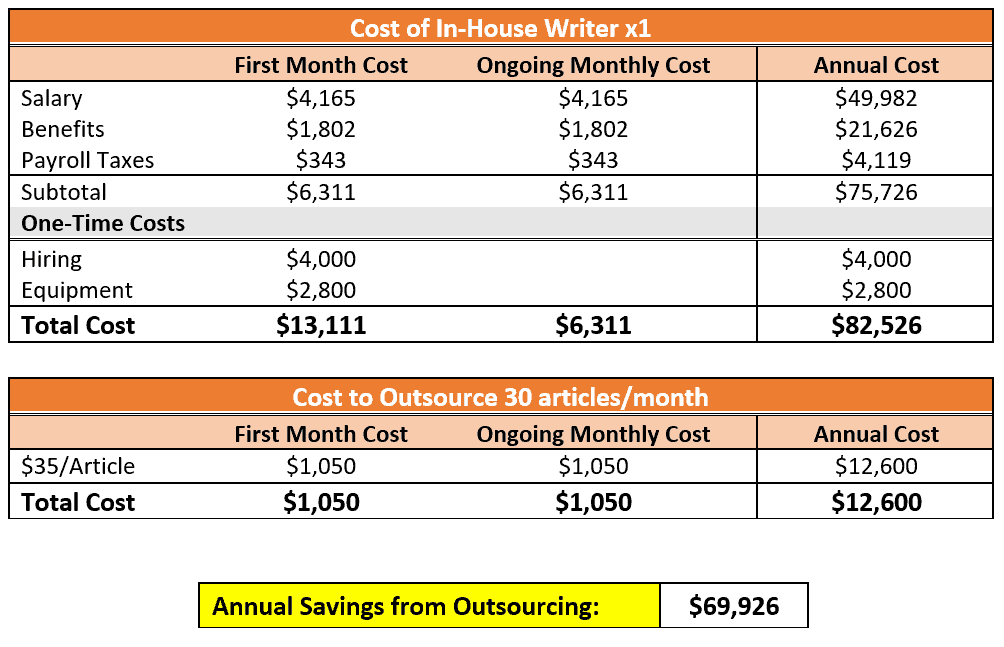
Summary: If you’re a small business with low volume content needs, it doesn’t make much financial sense to hire an annual in-house writer since we already know that one writer can produce well over 30 articles per month.
To even consider the idea of bringing your content writing in-house, you’d likely need to make sure this employee has a wider skill set than writing and can help in other parts of the business. Otherwise, you’d want to wait to bring a writer in-house until you have the equivalent of 125, 500-550 word articles for them to do.
Even at the maxed writing capacity of 125 articles a month, the outsourcing cost would still only be $73,264.80 (accounting for a volume discounted price of $34.30 per article), whereas the in-house cost would stay the same as what’s in the graph above. That’s still a savings of $9,261.57 when going the outsourced content writing route. If you were to just buy blog posts as you need them from outsourced content writing services, it would save you a lot of money in the long run.
Scenario 2: An SEO/Marketing Agency
Background: When managing other companies’ content and digital marketing, quality writing becomes especially critical. With 250 pieces of content to create each month between several clients, you need to make sure you’ve got a solid writing team in place. If you wanted to bring this content writing in-house, you would need to hire two full-time content writers. You’d probably also want to consider hiring one full-time editor as well, but that’s a discussion for another day.
- # of Pieces of Content Needed: 250 per month
- Article Word Size: 500 words
- # of In-House Writers Needed: 2
- Outsourcing Discount Pricing: $34.30 per article
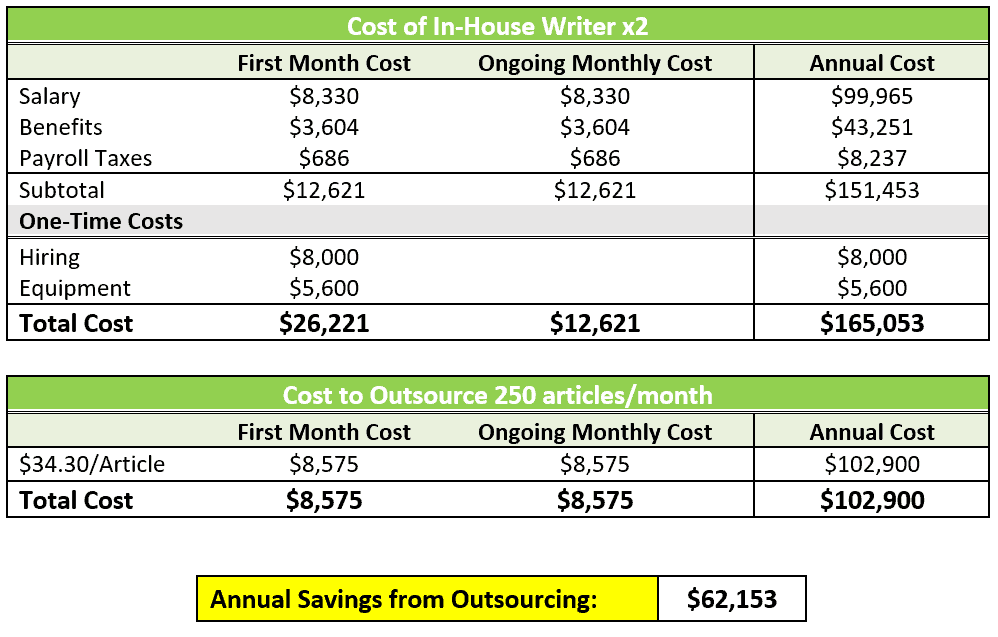
Summary: With SEO agency services ranging everywhere from content creation to keyword research, PPC, SERP rankings, reputation management and more, the easier you can make the content creation process while keeping quality high, the better. From the cost breakdown above, it can make a lot of sense to buy blog posts from a provider to allow you to focus your resources on other sectors of your service or product line.
One of the caveats to using a content writing service, however, is making sure you select one that can customize to your business model and integrate with your processes. If using an content writing services’ platform decreases efficiency and adds cost, that should be considered.
Scenario 3: A Large Enterprise with High Content Volume
Background: You already have a strong marketing department, but you need to up your content writing to help fulfill ongoing campaigns across several different departments. Assume that you are looking to produce 500, 500-word blog posts per month. Using the above rate of 125 articles per writer, you would need to hire four full-time content writers to handle the volume.
- # of Blog Posts Needed: 500 per month
- Article Word Size: 500 words
- # of In-House Writers Needed: 4
- Outsourcing Discount Pricing: $33.95 per article
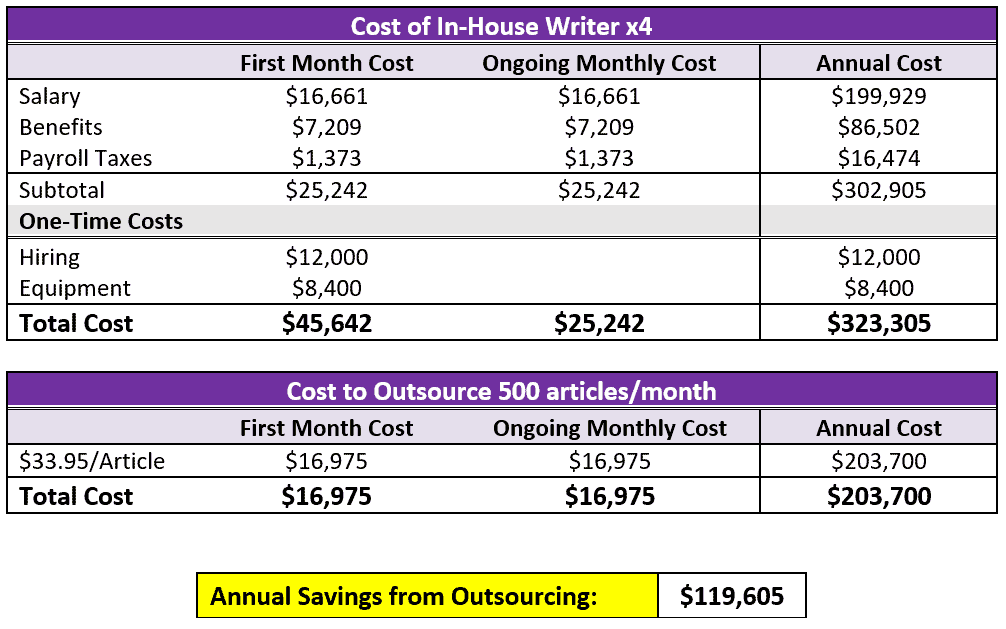
Summary: While there are some perks to having content writers in your physical office, it may not be worth what it will cost you.
This could be a scenario where getting some add-ons from the outsourced content writing service (such as higher quality writing teams/editing/images/posting) could further increase the overall value of the service while STILL largely undercutting the costs of having in-house writers.
The trade-off is that if you outsource to an article writing service, you would need to make sure your brand style guide is very clear and that there are checks in place to ensure a consistent brand image. Depending on the article writing services you’re considering, you can ask to have a dedicated team of writers who are trained on your specific projects – at no cost to you.
Scenario 4: An Ecommerce Business Scaling Seasonal, High-Volume Projects
Background: Suppose you need 20,000 SKUs (100-word product descriptions) completed in the next 6 months. Adjusting the content writing rate for product type, word count, and internal survey data, a high quality content writer could complete an average of 4.25 SKUS an hour, or 680 a month. To fulfill this in-house, you would need to hire five web content writers. If you outsource it, you could actually get the project done in 3 months (due to having access to many more than 5 content writers).
Obviously, you wouldn’t need a year-round content staff. The in-house figures below include hiring costs, prorated salaries/taxes/subscriptions, no benefits, and half of the one-time equipment expenses. We’ll assume that you can sell back your equipment at 50% once the project is finished.
- # of Product Descriptions Needed: One-time, 20,000 SKU order
- Article Word Size: 100 words
- # of In-House Writers Needed: 5
- Outsourcing Discount Pricing: $4.84 per description
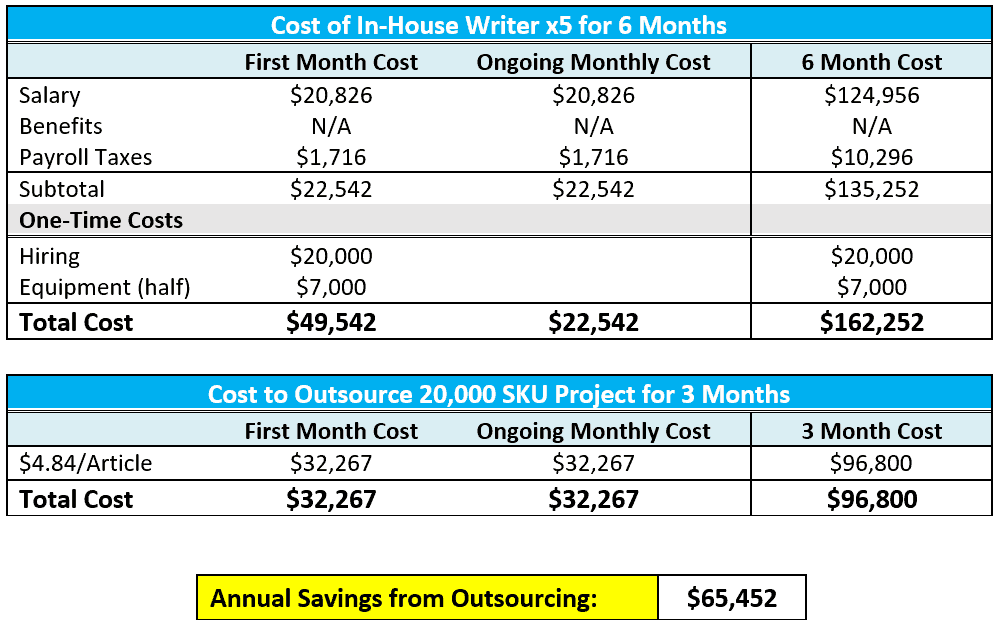
Summary: This scenario showcases the value of outsourcing when it comes to high volume, one-time/seasonal eCommerce projects. Not only does outsourcing reduce the overall costs by nearly 40 percent (in this scenario), but you also must consider the potential revenue acquired from having your catalog of product descriptions go live three months ahead of schedule.
Final Cost Comparison: Outsourcing Content Writing vs. In-House Writers
So how do the cost savings breakdown from scenario to scenario? As you can see below, outsourcing to article writing services is the clear winner, and it’s not close:

Ultimately, maximizing the value of your content marketing budget largely depends on the volume and duration of your content campaigns. In most cases, companies will save quite a bit of money and time by outsourcing to high quality writing services. This is money that can go directly back into your bottom line, or that can be reinvested into other parts of the business that need work. Imagine all the things your business could do with an additional $60-$100k lying around!
Should You Even Consider In-House Writers?
Looking at the above scenarios, you may be inclined to answer this question with a “no.” While it’s true that in-house writing teams don’t make financial sense in most traditional business verticals, there are some scenarios where it may be necessary.
In-house writers may make sense for smaller, more technical content projects that don’t fall under the industry averages we’ve clarified above. This may include certain niche industries (advanced engineering, science, technology, medical) where the writer expertise/knowledge requirements fall out of the range of most outsourced content writing companies. Also, if money truly is not an issue, and you just want to have complete control over the training, managing, and production of the writers, you might consider an in-house writing and editing team.
That being said, you should keep in mind the auxiliary costs of running your own content writing team, particularly if you’re short on space. Hiring a dedicated manager for your writers and creating/using a management system to keep processes moving smoothly are things we didn’t factor into this comparison but would also add to the in-house cost.
In the end, most companies are having a difficult time sourcing writers who are both creative and analytical, which is why nearly 44 percent of marketers are now outsourcing to blog content writing companies.
Why You Should Outsource with BKA Content
If you’ve decided to try outsourcing to a content writing company, you should note that not all content writing companies are created equal. As was stated above, they follow several different pricing and account management models, so you’ll want to be selective of the features that bring the most benefits.
In regard to BKA Content, here is how we stack up. We’ve been in the online writing industry since 2009, and we have loads of experience crafting high-quality content for thousands of agencies, enterprises, eCommerce companies and small businesses. We pride ourselves in contracting only the best U.S. writers as well as providing extraordinary customer service. Our mission is to become a trusted content extension of any business, not just a neat piece of software.

We offer account management free of charge and don’t require any retainer fees, contracts or volume minimums. We are also unique in that we customize to clients’ processes instead of making them conform to us. We have a stringent qualifying process for bringing new writers on board to help ensure quality and consistency.
Conclusion
It’s clear that there is a lot of money to be saved when outsourcing your content to high quality content writers. Finding the right provider that can become a partner is imperative to making that work. Here at BKA Content, we are convinced we can help take your content campaigns to the next level.
Contact us today to see how we can help reduce your costs and enhance your content writing productivity and results!
How much can BKA save you?
Download this white paper
The Content Marketing Institute, 2017 Benchmarks, Budgets and Trends –North America http://contentmarketinginstitute.com/wp-content/uploads/2016/09/2017_B2B_Research_FINAL.pdf
Hubspot, “How Often Should Companies Blog?” https://blog.hubspot.com/marketing/blogging-frequency-benchmarks#sm.0000110b80p9e7ct0pbncwcv7i6y8
Hubspot “State of Inbound Report, 2016”
The Creative Group, “2017 Salary Forecast” https://www.roberthalf.com/creativegroup/salary-center-for-creative-and-marketing-professionals
Linkedin Marketing Solutions “The 2014 Professional Content Consumption Report” https://business.linkedin.com/marketing-solutions/c/14/6/linkedin-professional-content-consumption-report
Kapost 2014 Content Hiring Survey
Bureau of Labor Statistics (BLS)
Internal Revenue Service (IRS) 2017 Tax Code
- How To Use Keywords in Your Content for SEO - September 20, 2024
- Creating Google-Friendly Content - December 31, 2023
- Which Type of Content Brings In the Most Traffic? - December 28, 2023
